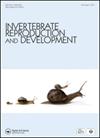Embryonic development, eclosion and performance of juvenile noble crayfish Astacus astacus (L. 1758) in response to shortened cold period
IF 0.8
4区 生物学
Q4 REPRODUCTIVE BIOLOGY
引用次数: 0
Abstract
ABSTRACT A suitable temperature regime in artificial incubation of crayfish eggs is crucial for successful application in aquaculture production and conservation projects. We studied the effect of different extended cold periods (CP: 10, 24 and 38 days at 7.5 ± 0.5°C) during artificial incubation on embryonic development, incubation efficiency and subsequent juvenile crayfish performance in noble crayfish. Best results were obtained at 38-day CP with stage II survival rate of 60.4 ± 7.4% and stage II wet weight of 38.4 ± 1.9 mg. This regime synchronized embryonic development and equally reduced hatching and moulting period to 7 days with no overlap between both. Survival was high in a subsequent 100-day rearing experiment (10-day CP: 85.0 ± 9.2%; 24-day CP: 90.0 ± 4.1%; 38-day CP: 92.5 ± 2.9%) and juvenile crayfish from 38-day CP grew faster, but these results were not significant. Staggered response of embryonic development to temperature rise and improved juvenile fitness at longer CP illustrate that dormancy of noble crayfish eggs represents a form of true diapause that is regulated solely by temperature and can be accelerated beyond a threshold only at the expense of higher mortality and reduced juvenile fitness.贵族小龙虾幼虾Astacus Astacus(L.1758)对寒冷期缩短的胚胎发育、羽化和性能
摘要小龙虾卵人工孵化的适宜温度制度对于在水产养殖生产和保护项目中的成功应用至关重要。我们研究了人工孵化过程中不同延长冷期(CP:10、24和38天,温度为7.5±0.5°C)对高贵小龙虾胚胎发育、孵化效率和随后幼龙虾表现的影响。在38天的CP中获得了最佳结果,II期存活率为60.4±7.4%,II期湿重为38.4±1.9 mg。该方案同步了胚胎发育,并将孵化和换羽期平均缩短至7天,两者之间没有重叠。在随后的100天饲养实验中,存活率很高(10天CP:85.0±9.2%;24天CP:90.0±4.1%;38天CP:92.5±2.9%),38天CP的幼小龙虾生长更快,但这些结果并不显著。胚胎发育对温度升高的交错反应和在较长CP下幼仔适应性的改善表明,高贵小龙虾卵的休眠代表了一种真正的滞育形式,它只受温度的调节,并且只有以较高的死亡率和幼仔适应性降低为代价才能加速超过阈值。
本文章由计算机程序翻译,如有差异,请以英文原文为准。
求助全文
约1分钟内获得全文
求助全文
来源期刊
CiteScore
1.90
自引率
0.00%
发文量
21
审稿时长
>12 weeks
期刊介绍:
Invertebrate Reproduction & Development ( IRD) presents original research on the reproductive and developmental biology of the Invertebrata, both embryonic and postembryonic. IRD welcomes papers reporting significant results obtained using new techniques. Encouraged topic areas include: aquaculture, physiology, biochemistry, functional morphology, phylogeny, behavioural and regulatory mechanisms, including genetic, endocrine and molecular studies. Papers containing qualitative descriptions of reproductive cycles and gametogenesis will not be considered. IRD is published in association with the International Society of Invertebrate Reproduction and Development.

 求助内容:
求助内容: 应助结果提醒方式:
应助结果提醒方式:


